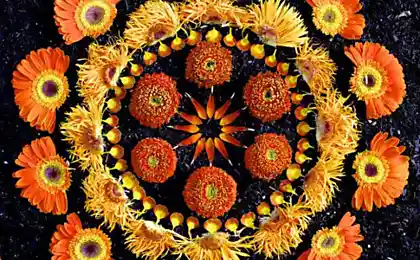1015
Mandala
Countless perfect worlds, amazing finesse lines, grace and harmony of colors forms ... as many as the stars in the firmament as enlightened beings in the infinite space. Hearing them, we gain a blessing; contemplating their faith in the heart, cleansed of defilements, veiled our minds since time without beginning ...
2500 years ago the Buddha Sakyamuni, reaching full and final enlightenment in Bodhgaya, taught his disciples two types of exercises. The first of these, the sutras, passed them openly in the form of dialogues and accessible to the public. The second tantra, the Buddha taught in secret and only those students who had high enough spiritual level to comprehend and implement them.

As the highest teachings, Tantra means achieving enlightenment through contemplation enlightened deities and their palaces-mandalas. Each mandala is a graphical representation of a tantric teachings, passing it the essence of the language of symbols that are understandable to contemporaries of the Buddha Sakyamuni. It can be "read" to learn how to text and store for later playback in meditation.
Mastering Tantra, the student remembers in detail the appearance of an enlightened deity and his palace, preparing himself for "entry into the mandala," that is at the pure state of mind in which resides the deity. In meditation mandala is reproduced in its three-dimensional shape - in Tantric Monastery, there are complex volumetric palaces, skillfully carved from wood. They serve as a visual aid, greatly facilitating the visualization process.

Along with the mental construction of three-dimensional mandalas in the rituals and practices used planar images that according to the texts can be either beautiful or made of crushed gemstones, colored and milled rice, flowers and colored sand.
Tantric practices and rituals that involve the construction of sand mandalas, being initially secret, until recently, were completely inaccessible for Westerners due to the geographical remoteness of Tibet, language and cultural barriers. They have been studied mainly in the major Tantric Monastery, where the monks came to fifteen training. Tibetans lay although aware of the existence of complex but effective tantric practices for the most part considered them the prerogative of monks and monasteries were limited to making offerings during major ceremonies.

The situation changed dramatically half a century ago, when the free Buddhist Tibet was conquered by China, to preach the ideas of communism and atheism. Six thousand monasteries, centuries-old knowledge of the mainstays, with huge libraries, were swept away, thousands of monks and nuns killed, maimed, imprisoned. These days, the young Dalai Lama XIV, Tenzin Gyatso, the head of the spiritual and temporal power in Tibet, has decided to leave his country to establish a government in exile and of free India to support its people. It was followed by thousands of monks and lay people: all those who managed to escape. The game has changed, before Tibetans faced a difficult task to preserve their unique spiritual culture in the conditions of exile. Monks and lamas moved to the west, where they waited for the people who had heard about the mysticism and the sacraments of Tibet from casual travelers who due to life circumstances lucky enough to visit the Land of Snows. And although people rarely concur and are prone to conflicts, the image of Tibet, entrenched in the minds of the peoples of different countries was almost identical. He pictured them as the last stronghold of spirituality, accidentally survive in the war-torn world and contradictions. With an open heart Westerners met Tibetan lamas and monks, and they generously shared his knowledge with them. So the West first came secret tantric rituals, and with them the sand mandala.

The decision to allow Tibetan monks build sand mandala in the West was made by His Holiness the Dalai Lama XIV, who pursued multiple objectives. On the one hand, it was a priceless gift to the people of those countries which, because of its openness and compassion, have been willing to lend a helping hand to Tibet. After all tantric rituals involving the construction of sand castles and inviting them enlightened beings who have attained omniscience and reveal a full potential, clean space, to restore the broken balance in nature and harmonize the relationship between living creatures of all worlds. No matter how we treat mandala: how to breathtaking work of art or a sacred object worthy of worship, it gives us so many blessings as tiny grains of sand goes into its construction. It frees us from diseases, distresses, fears and bad thoughts. Knowing this, the Tibetans traditionally express mandala homage to enhance the positive effect that it can have on their lives: make it stretch to make her offerings and go around it clockwise.

On the other hand, building a sand mandala in the West, Tibetan monks could tell people about its unique culture, which happened due to historical reasons on the verge of extinction. Venue for tantric rituals have become museums, galleries and concert halls. The West tried to examine a sand painting in an art context, and particularly zealous pedants saw this discrediting secret practices. In Tibet had its own point of view. "Some people in the audience may wonder - said His Holiness the Dalai Lama XIV, when first brought to the West monks Gyuto Tantric Monastery - is it possible to demonstrate the tantric rituals of secular public? This is the secret teachings - they say - is it possible to show them for fun? But internal processes accompanying rituals and insights obtained in meditation, you can not see his eyes. At the same time observe the outside of the ritual is very favorable, because it creates in the mind of the connection to the data practices and reveals the inherent potential in us. Although extremely difficult to practice and fully grasp the essence of tantra, Tibetans are always going to look at the outside of the ritual. "
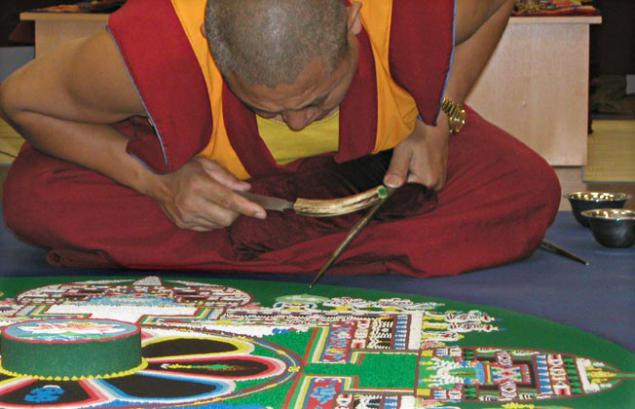
In this age of decline opportunities to sow seed of enlightenment in the human heart far from negligible Buddhism: one pushes the complexity of terminology and other exotic oriental religions. Tibetan monks pass by these barriers completely incomprehensible way: with everyone who comes to them, they speak a language which he understands. Indeed, they have the key to the heart of everyone.
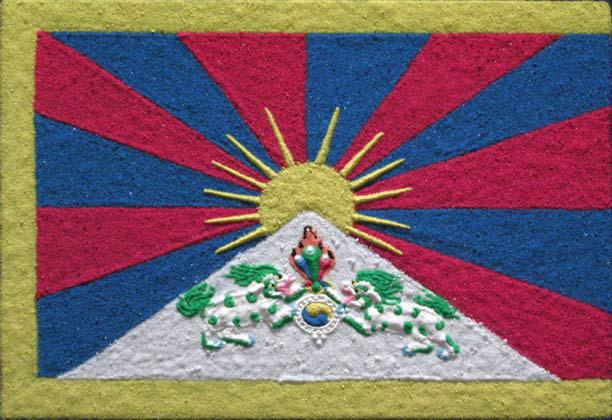
Monks in suits tantric deities

Boys monks on the day of monasticism. Gyudmed monastery. India

Community of monks Gyudmed before entering the temple. The opening day of the temple. India. 1991

His Holiness the Dalai Lama XIV
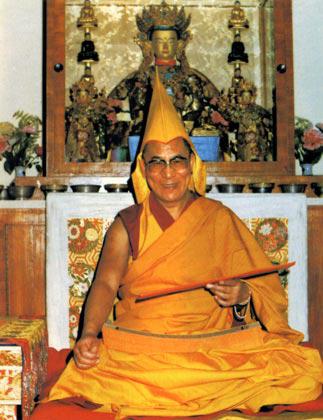
The monks Gyudmed

Tibet

Buddhist stupa. Tibet. taken here: www.centre.smr.ru/win/facts/mandala/mandala_vvod.htm
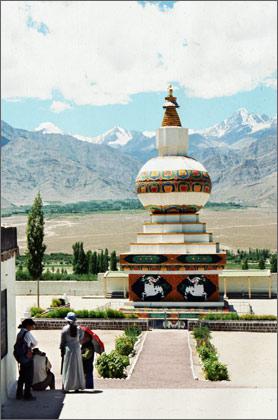
Source:
2500 years ago the Buddha Sakyamuni, reaching full and final enlightenment in Bodhgaya, taught his disciples two types of exercises. The first of these, the sutras, passed them openly in the form of dialogues and accessible to the public. The second tantra, the Buddha taught in secret and only those students who had high enough spiritual level to comprehend and implement them.

As the highest teachings, Tantra means achieving enlightenment through contemplation enlightened deities and their palaces-mandalas. Each mandala is a graphical representation of a tantric teachings, passing it the essence of the language of symbols that are understandable to contemporaries of the Buddha Sakyamuni. It can be "read" to learn how to text and store for later playback in meditation.
Mastering Tantra, the student remembers in detail the appearance of an enlightened deity and his palace, preparing himself for "entry into the mandala," that is at the pure state of mind in which resides the deity. In meditation mandala is reproduced in its three-dimensional shape - in Tantric Monastery, there are complex volumetric palaces, skillfully carved from wood. They serve as a visual aid, greatly facilitating the visualization process.

Along with the mental construction of three-dimensional mandalas in the rituals and practices used planar images that according to the texts can be either beautiful or made of crushed gemstones, colored and milled rice, flowers and colored sand.
Tantric practices and rituals that involve the construction of sand mandalas, being initially secret, until recently, were completely inaccessible for Westerners due to the geographical remoteness of Tibet, language and cultural barriers. They have been studied mainly in the major Tantric Monastery, where the monks came to fifteen training. Tibetans lay although aware of the existence of complex but effective tantric practices for the most part considered them the prerogative of monks and monasteries were limited to making offerings during major ceremonies.

The situation changed dramatically half a century ago, when the free Buddhist Tibet was conquered by China, to preach the ideas of communism and atheism. Six thousand monasteries, centuries-old knowledge of the mainstays, with huge libraries, were swept away, thousands of monks and nuns killed, maimed, imprisoned. These days, the young Dalai Lama XIV, Tenzin Gyatso, the head of the spiritual and temporal power in Tibet, has decided to leave his country to establish a government in exile and of free India to support its people. It was followed by thousands of monks and lay people: all those who managed to escape. The game has changed, before Tibetans faced a difficult task to preserve their unique spiritual culture in the conditions of exile. Monks and lamas moved to the west, where they waited for the people who had heard about the mysticism and the sacraments of Tibet from casual travelers who due to life circumstances lucky enough to visit the Land of Snows. And although people rarely concur and are prone to conflicts, the image of Tibet, entrenched in the minds of the peoples of different countries was almost identical. He pictured them as the last stronghold of spirituality, accidentally survive in the war-torn world and contradictions. With an open heart Westerners met Tibetan lamas and monks, and they generously shared his knowledge with them. So the West first came secret tantric rituals, and with them the sand mandala.

The decision to allow Tibetan monks build sand mandala in the West was made by His Holiness the Dalai Lama XIV, who pursued multiple objectives. On the one hand, it was a priceless gift to the people of those countries which, because of its openness and compassion, have been willing to lend a helping hand to Tibet. After all tantric rituals involving the construction of sand castles and inviting them enlightened beings who have attained omniscience and reveal a full potential, clean space, to restore the broken balance in nature and harmonize the relationship between living creatures of all worlds. No matter how we treat mandala: how to breathtaking work of art or a sacred object worthy of worship, it gives us so many blessings as tiny grains of sand goes into its construction. It frees us from diseases, distresses, fears and bad thoughts. Knowing this, the Tibetans traditionally express mandala homage to enhance the positive effect that it can have on their lives: make it stretch to make her offerings and go around it clockwise.

On the other hand, building a sand mandala in the West, Tibetan monks could tell people about its unique culture, which happened due to historical reasons on the verge of extinction. Venue for tantric rituals have become museums, galleries and concert halls. The West tried to examine a sand painting in an art context, and particularly zealous pedants saw this discrediting secret practices. In Tibet had its own point of view. "Some people in the audience may wonder - said His Holiness the Dalai Lama XIV, when first brought to the West monks Gyuto Tantric Monastery - is it possible to demonstrate the tantric rituals of secular public? This is the secret teachings - they say - is it possible to show them for fun? But internal processes accompanying rituals and insights obtained in meditation, you can not see his eyes. At the same time observe the outside of the ritual is very favorable, because it creates in the mind of the connection to the data practices and reveals the inherent potential in us. Although extremely difficult to practice and fully grasp the essence of tantra, Tibetans are always going to look at the outside of the ritual. "

In this age of decline opportunities to sow seed of enlightenment in the human heart far from negligible Buddhism: one pushes the complexity of terminology and other exotic oriental religions. Tibetan monks pass by these barriers completely incomprehensible way: with everyone who comes to them, they speak a language which he understands. Indeed, they have the key to the heart of everyone.

Monks in suits tantric deities

Boys monks on the day of monasticism. Gyudmed monastery. India

Community of monks Gyudmed before entering the temple. The opening day of the temple. India. 1991

His Holiness the Dalai Lama XIV

The monks Gyudmed

Tibet

Buddhist stupa. Tibet. taken here: www.centre.smr.ru/win/facts/mandala/mandala_vvod.htm

Source:















